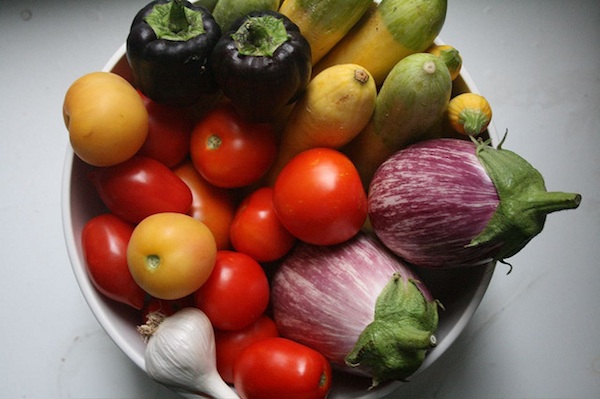Whether you’re looking for tips on frugal living, skills to be more self sufficient, or just want to learn more about simple living, you’re going to love these homesteading ideas. These 10 hacks will teach you how homesteaders save money in practical ways. Stop by for all the details.

Photo credit: David Walburn The StoneHouse at Duck Lake – Montana
People are always amazed when they find out just how little money we spend on…well…anything. They always ask, “How do you do that?” I think what they really want to know is, “How can I do that?”
Here are 10 things we homesteaders do that save us money and could save you money too.
1. Grow their own food
Homesteaders are well known to grow their own food including fruits, vegetables, nuts, meats, fish, eggs, dairy, herbs, wheat, and oats.
When you grow your own food, you don’t need to purchase food or pay for the fuel to go shopping.
How much do you spend on food each month? Multiply that by 12. What would your bank account look like if you didn’t spend that money every year?
Try it now: If you’ve never grown a garden before—start small. If you do grow a garden, try growing more than normal. If your bounty normally lasts until October, try to make it to November. If you don’t have acreage to grow a garden, try growing some foods inside.
2. Eat what they already have
Homesteaders generally eat what’s in their food storage. This is the one that’s not so obvious.
Think of all the times you don’t have time to cook, or you don’t know what to cook—so you just go get something or eat out.
Now think of all the food you throw away. Do left-overs spoil in your fridge? Do you find expired food in your pantry?
If you add these two up, it’s quite the price tag—even for frugal families.
Try it now: Next time you would normally go shopping, eat what you have for another week—unless you’ve really run completely out of food. If you would normally shop every week, try to go two weeks. Eat what’s in your fridge and food storage. I bet you’ll see a difference in your finances.

Photo Credit: Steve Snodgrass CC
3. Reuse items
When friends buy laundry detergent in bulk, they give me the big square tubs and I use them to store my dried foods, flour, sugar, oats, and many other things in.
We never throw anything away if it can be used for something else. This keeps us from buying many items that we would otherwise need.
Try it now: Be aware of the things you throw in the trash this week. Try to reuse one thing each day before throwing it away. Diaper box? Let the kids play in it or draw on it. Milk jug? Cut the top off and grow radishes inside.
4. Own things
Homesteaders usually don’t owe money. They save up cash and buy what they need with it—like their land and home. When you don’t make payments, you aren’t paying interest.
Try it now: The first step to this is getting out of any debt. If you have debt, pay as much as you can as fast as you can and go without unneeded luxuries.
The next step is not buying anything you don’t need until you have the cash in your hand. Set up a special savings account, and make payments to the account each month instead of a lender. When you have the money, consider if you still want the item.
Related: Should I Start A Budget?

Photo Credit: Loughborough University Library CC
5. Use the library
Look at your bookshelf and pull out every book you’ve never read. Multiply that by the average price you pay for a book—that money could be in your bank account.
Homesteaders not only use the library for books but for the internet too (since they don’t have internet access at home.) Do you homeschool? Your library can save you a ton of money. My library has a list of every book in the state. If I request a book and am willing to wait the 1-2 weeks, I can borrow it for free. Most of my kids’ science books are obtained this way.
Try it now: See if you can stay off your internet at home and not buy any books for a week. Go to the library for any research, social media, or on-line ordering you may need. If you conquer this, try it for a month. You’ll probably find other things you want to do with your time. Consider if you could go without home internet service—and save a little on your electric bill too.
6. Walk or ride their horse instead of driving
Fuel is expensive. Walking, snow shoeing, and horseback riding are the way to get around out in the country. Even with SUVs and Diesel trucks, we don’t buy fuel very often—in fact it’s been six months since I fueled my SUV and it’s nearly full.
Try it now: Not everyone has a horse, I get it. Try riding your bike, taking the bus, train, or even car-pooling. You may surprise yourself at how much you don’t need your vehicle, and how much you save on fuel.

Photo Credit: thebittenword.com CC
7. Barter
We don’t always have money—be we do generally have things that other people need. Why not trade? This is a weekly occurrence, if not more often. In the summer and fall, I can take my extra produce to the local market and get store credit for the other things we need (like coffee). Homesteaders trade food, services and items no longer needed.
Try it now: Need a house sitter? Try offering a service or talent of yours to someone to watch your house for you. Need your neighbor to work on your car? Offer to babysit his kids one night so he can go on a date with his wife.
8. Use it up, wear it out or make do
This is just what it sounds like. Clothes don’t get thrown away until they are worn out. That last bit of detergent doesn’t get tossed when the bottle gets low—it gets used. Don’t have enough baking powder for that biscuit recipe? Substitute or make a different recipe.
Try it now: Never throw away your clothes if they are still good. Try specifically to give them to someone you know (or barter?). If no one comes to mind, donate them in lieu of throwing them away. Turn those pants you hate into cute capris. Skip your next clothes shopping trip if you don’t need an item.

Photo Credit: J.K. Califf CC
9. Have learned to be content
When I first got married, I wanted to build a new house down by the river. I also missed the swimming pool I had that I swam in every morning and wanted one of those. I never got either one. I now know I don’t have time to swim and take care of a pool, and I have fallen in love with this little farm house.
Homesteaders don’t purchase things unless they really need it. I am content and now happy with the layout of our farm. It would have cost hundreds of thousands of dollars to do what I wanted and I wouldn’t have been any happier.
Try it now: Make a list of what you really want right now. Are any of these things you need? Now make a list of how you can be content and even happy without spending money in these areas.
10. Develop priorities
We don’t have time to do it all and buy it all.
It’s tempting to start another project in the middle of the current one—and then start another project while in the midst of the second one. But if you let yourself fall to this temptation, you’ve wasted money on unfinished projects that you can’t use.
Figure out what’s important and invest in that. Once that project is done, you may find your priorities have changed for the rest of your list.
Try it now: If you’ve already started house projects, don’t start any more until these are done. Then pick new projects one at a time to start and finish.
If your child suddenly wants to play every instrument, take dance, and play baseball, ask him/her to prioritize.
Whew! That was a lot. What can you pick off the list to try? Let us know if you’re willing to give one a shot and then check back and tell us how it goes.

After growing up and working in large cities like Sacramento and Chicago, Deborah met her Farmer through unusual circumstances and moved onto the original homestead settled by his family. From the fast paced life of trauma and heart surgery to the new challenge of living off the land, homeschooling, and women’s ministry; her world has taken a complete turn. Life skills have changed and so have finances–both in dramatic ways. Here Deborah shares the skills she has learned to adjust to a simpler, more self-sufficient, and frugal lifestyle.
More Ways To Save Money
3 Ways to Watch Free Movies Online
Easy Ways to Stock the Freezer
9 Must-Have Tips to Save Money at the Grocery Store


We live very frugally by necessity. Even so, I saw some things on your list that will be helpful to me. Particularly, finishing one thing before I start the next!
Blessings,
Laura of Harvest Lane Cottage
I still struggle with this one Laura. I find that when I have been able to stick it out and make it to the next project it has made a dramatic difference in our finances.
Glad you found some pointers that may bless you!
These are really god tips. Most of them I use already but there are a few I need to get better at. Thank you for sharing.
There are a few that I need to work on too so I’m totally there with you, Rose!
Thanks for stopping by!
Thanks for the tips. I have a small garden and am usually able to put up a small amount of food in my freezer. I also am part of a produce co-op and I take opportunities to get extra produce to put up into jam, my freezer, or dehydrate. I don’t bake my own bread very often, but through the co-op I am able to buy organic bread in bulk at a really good price. I freeze it and we miss if if and when we run out. I didn’t really want to go shopping this weekend, so maybe I’ll work at using up some of what I having in my freezer and pantry. I think I’m low on veggies, but I can probably make do for a few days.
Great idea, Deborah! :O)
I’ll dig around and see what I can find – I’ve never tried a co-op myself!
I love all you ideas – and am already doing most of them – (i once got a fortune cookie fortune that said “you will never have enough time to finish everything by yourself”! Seriously!) Wish I could take that more to heart….
But here’s another great idea for growing your own produce: Sprouts! There are so many possibilities, along with the usual mung and alfafa – sunflower seeds, garbanzoes, wheat berries (use the hard, not soft), broccoli, & other microgreens. In a few days, the process of sprouting turns the seed from a grain carbohydrate into a vegetable carbohydrates – much easier for your body to digest.) You’ll never buy produce fresher than a crop of sprouts, freshly grown!
Thanks so much for the tip on the sprouts, Melanie!
We homestead as well and while we technically fall under the poverty line, it never feels like we are are poor. Our bills come right around $800 a month. That leaves us several hundred for projects and saving each month. We follow many of these same principals and also sell extra produce and eggs along with crochet items to supplement our income.
Good for you for making the best out of your situation!
Thanks for stopping by and sharing!
Great list, here are a few more ideas to add to it.
Find a meat co-op in your area, healthier meat, cheaper prices. You can usually find out about them at your local ag store or try your local farm association. If you live in a city you might have to travel the burbs.
Use those buckets you were talking about to grow tomatoes or peppers. They work great for both.
Hang dry your clothes, huge savings on utility bills.
One last thing, horses will probably never save you money (says the girl that owns 3 lol) You can find ways to keep the cost of horse ownership down, but probably not enough to save on gas.
Great post,
Michele
I especially love your tips for saving on meat. Thanks for sharing, Michele!
Your horse comment makes me giggle Michele. I have a friend closer to town who has fancy horses and only 20 acres and she would definitely agree with you. Our homestead however, is 1000 acres and we are off-grid & self-sufficient, which means we grow all their food, completely own their home, and as farmers, if we aren’t driving tractors, we really do take them to work every day :-) . We handle most medical issues ourselves, and if we do need to see the vet, we barter for meat (we grow our own and hunt). I literally drive my vehicle about twice a year (that’s how often we go grocery shopping) unless medical issues come up. For us, paying for fuel every day would be a financial hardship–but like I said, it’s not feasible for everyone–that’s where bikes, buses, and car-pooling come in.
Love the ideas on growing veggies in buckets.
Thanks for this list! Ithe is helpful for someone just starting on their homesteading journey.
You’re more than welcome. Thanks for stopping by, Katie!
Katie, just dropped by your site–very cute. You guys are moving right along and looks like you are rocking it! I always love to watch others get started in their off-grid journey. We are living off the land originally homesteaded to our family and we often think of how overwhelming it would be to start all over again–you make it look easy :-) .
Just a thought, but before you post our photo of our Montana cabin for your blog post, you might consider asking for permission.
Or better yet, you could have done an article about how we homesteaded this cabin instead of taking the photo and using it as your own.
The Walburn’s – StoneHouse at Duck Lake
I apologize JJ. The photo was provided by the guest poster and I wasn’t aware that she didn’t have permission to use it. I have credited the photo to Stonehouse at Duck Lake. Take care!